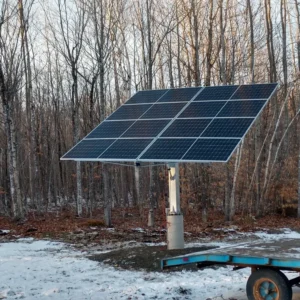
As the world moves towards more sustainable energy solutions, solar power remains a leading choice due to its ability to harness the sun’s abundant energy. One of the most effective ways to improve the efficiency of solar panels is by using solar tracker. These devices allow solar panels to follow the movement of the sun throughout the day, ensuring maximum exposure to sunlight. Among the different types of solar trackers, dual-axis solar trackers stand out for their ability to track both the azimuth and elevation of the sun. In this article, we will explore the advantages of solar trackers, with a focus on dual-axis solar trackers, and how they help optimize solar energy production.
What is a Solar Tracker?
A solar tracker is a device that adjusts the position of solar panels to follow the sun’s path, ensuring that they receive the maximum amount of sunlight throughout the day. Unlike fixed solar panels, which remain stationary and only face a specific direction, solar trackers are designed to move and track the sun’s movement. This results in a significant increase in energy production, as solar panels can capture more sunlight during the day.
Types of Solar Trackers
There are two primary types of solar trackers: single-axis and dual-axis. Both are designed to increase the efficiency of solar energy systems, but they differ in how they move the panels.
Single-Axis Solar Trackers
Single-axis solar trackers are designed to move in one direction, typically along the east-to-west axis. This allows them to track the sun’s movement throughout the day as it rises in the east and sets in the west. While single-axis trackers can improve energy production, they are limited in their ability to adjust to the sun’s position during different seasons and weather conditions.
Dual-Axis Solar Trackers
Dual-axis solar trackers are more advanced and can move both horizontally and vertically. This allows them to track the sun’s position across the sky, adjusting for changes in both its elevation and azimuth. By following the sun in two dimensions, dual-axis solar trackers ensure that solar panels are always positioned for optimal energy capture. This results in a more significant increase in energy production compared to single-axis trackers, especially in regions with variable weather conditions or during different times of the year.
Benefits of Dual Axis Solar Trackers
Dual-axis solar trackers offer several advantages over traditional fixed or single-axis systems, including improved energy efficiency, greater return on investment, and better adaptability to different environments.
Maximized Energy Production
By following the sun’s movement in two directions, dual-axis trackers are able to capture the maximum amount of sunlight throughout the day. This results in higher energy output compared to other types of solar tracking systems. In fact, dual-axis trackers can increase energy production by up to 40% or more, making them an excellent choice for maximizing the return on solar investments.
Enhanced Performance in Various Weather Conditions
Dual-axis trackers are particularly effective in regions where weather conditions change throughout the year. For example, during winter months when the sun is lower in the sky, dual-axis trackers can adjust the angle of the panels to capture more sunlight. Similarly, in areas with frequent cloud cover or occasional rain, the ability to adjust both the azimuth and elevation angles ensures that the panels remain positioned for optimal exposure.
Increased Lifespan of Solar Panels
By optimizing the amount of sunlight that solar panels receive, dual-axis trackers can also help extend the lifespan of the panels. With less exposure to shading or inefficient angles, the panels operate more efficiently, leading to less wear and tear over time. This can ultimately reduce maintenance costs and improve the overall cost-effectiveness of a solar energy system.
Conclusion
Solar trackers, particularly dual axis solar tracker, are an excellent solution for enhancing the efficiency of solar energy systems. By adjusting the position of solar panels to follow the sun’s path, these trackers maximize energy production, improve system performance, and extend the lifespan of solar panels. Whether you’re looking to optimize your existing solar energy system or invest in a new one, dual-axis solar trackers are a worthwhile consideration for any solar installation.